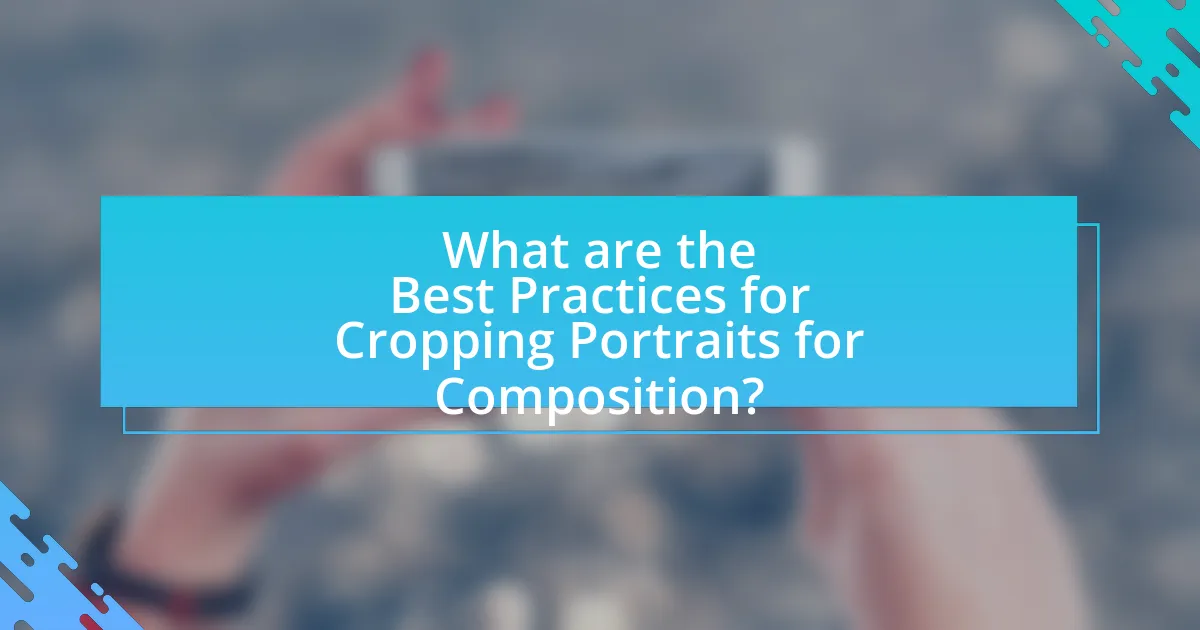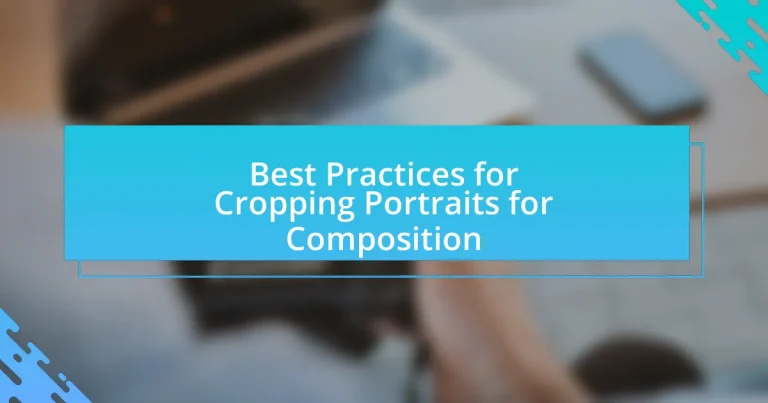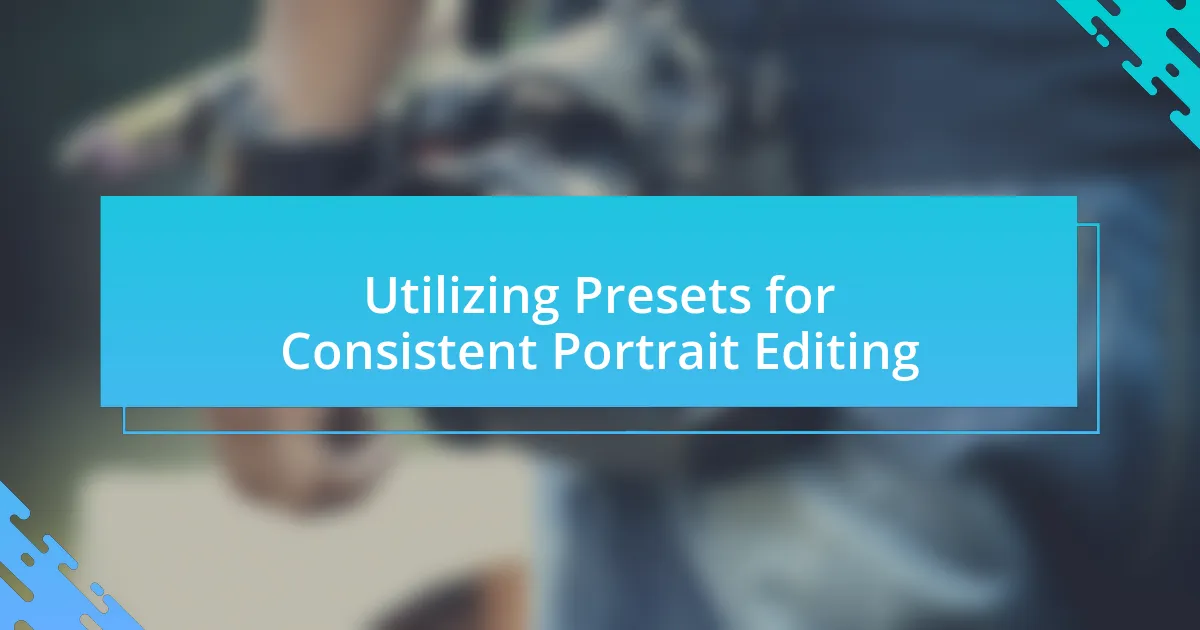The article focuses on best practices for cropping portraits to enhance composition. Key techniques discussed include the importance of positioning the subject’s eyes according to the rule of thirds, maintaining proper headroom, and utilizing negative space effectively. It explores how cropping impacts the overall composition by altering focus and balance, while also addressing common mistakes to avoid, such as cutting off essential features. Additionally, the article highlights the significance of aspect ratios and provides practical tips for preserving image quality during cropping, ensuring that portraits remain visually engaging and impactful.

What are the Best Practices for Cropping Portraits for Composition?
The best practices for cropping portraits for composition include focusing on the subject’s eyes, using the rule of thirds, and ensuring proper headroom. Positioning the eyes along the upper third of the frame draws attention and creates a more engaging image. The rule of thirds suggests dividing the frame into a 3×3 grid and placing the subject off-center, which enhances visual interest. Additionally, maintaining appropriate headroom—leaving space above the subject’s head—prevents a cramped appearance and allows for a balanced composition. These techniques are widely recognized in photography and are supported by principles of visual aesthetics.
How does cropping impact the overall composition of a portrait?
Cropping significantly impacts the overall composition of a portrait by altering the focus and balance of the image. When a portrait is cropped, it can emphasize the subject’s facial features or expressions, drawing the viewer’s attention directly to the most important elements. For instance, cropping tightly around the face can create a more intimate and engaging portrayal, while leaving more negative space can evoke feelings of isolation or contemplation. Research indicates that the rule of thirds, a compositional guideline, suggests placing the subject off-center to create a more dynamic image, which can be achieved through effective cropping. This technique enhances visual interest and guides the viewer’s eye, ultimately influencing the emotional response elicited by the portrait.
What are the key elements of composition in portrait photography?
The key elements of composition in portrait photography include framing, lighting, background, and the subject’s positioning. Framing directs the viewer’s attention to the subject, while effective lighting enhances features and sets the mood. The background should complement the subject without distracting from it, and the subject’s positioning can create a sense of balance or tension within the image. These elements work together to create a compelling portrait that captures the essence of the subject.
How does the rule of thirds apply to portrait cropping?
The rule of thirds applies to portrait cropping by guiding the placement of the subject within the frame to create a more balanced and engaging composition. This technique involves dividing the image into a 3×3 grid, where the key elements, such as the subject’s eyes or face, are positioned along the grid lines or at their intersections. Research in photography composition indicates that images aligned with the rule of thirds are often perceived as more aesthetically pleasing, enhancing viewer engagement. By strategically cropping portraits using this method, photographers can draw attention to the subject while maintaining a sense of harmony in the overall image.
Why is it important to consider the subject’s features when cropping?
Considering the subject’s features when cropping is crucial for maintaining the integrity and impact of the portrait. The subject’s features, such as facial expressions, body language, and unique characteristics, contribute significantly to the overall message and emotional resonance of the image. For instance, cropping too tightly around the face may eliminate important context provided by the subject’s posture or surroundings, which can alter the viewer’s interpretation. Research indicates that effective cropping enhances visual storytelling by emphasizing key elements while preserving the subject’s identity, thus ensuring that the composition remains engaging and meaningful.
How can cropping enhance or detract from facial features?
Cropping can enhance or detract from facial features by altering the focus and context of the image. When cropping is done effectively, it can emphasize key facial attributes, such as the eyes or smile, drawing the viewer’s attention to these features. For example, a tight crop around the face can create intimacy and highlight expressions, making the subject more engaging. Conversely, poor cropping can cut off important elements, such as the chin or forehead, leading to an unbalanced composition that detracts from the subject’s overall appearance. Research in photography composition indicates that maintaining a balance between the subject and negative space is crucial for visual appeal, supporting the idea that thoughtful cropping can significantly impact the perception of facial features.
What role does negative space play in portrait composition?
Negative space in portrait composition serves to enhance the subject’s prominence and create a balanced visual experience. By strategically utilizing empty areas around the subject, negative space draws attention to the focal point, allowing viewers to engage more deeply with the portrait. Research in visual perception indicates that effective use of negative space can lead to improved viewer focus and emotional response, as it provides context and breathing room, preventing the composition from feeling cluttered. This principle is widely recognized in art and photography, where artists often employ negative space to guide the viewer’s eye and convey a sense of harmony within the composition.

What techniques can be used for effective portrait cropping?
Effective portrait cropping techniques include the rule of thirds, centering, and using negative space. The rule of thirds involves dividing the image into a 3×3 grid and placing the subject along the grid lines or at their intersections, which enhances visual interest and balance. Centering the subject can create a strong focal point, especially in formal portraits, while utilizing negative space around the subject can emphasize their presence and create a more dynamic composition. These techniques are widely recognized in photography for improving composition and drawing attention to the subject.
How can different aspect ratios affect portrait cropping?
Different aspect ratios significantly influence portrait cropping by altering the composition and focus of the image. For instance, a 4:5 aspect ratio is commonly used for portraits as it closely matches the dimensions of traditional print sizes, allowing for a more natural framing of the subject’s face and upper body. In contrast, a 16:9 aspect ratio, often used for widescreen formats, can lead to a more expansive background, which may detract from the subject’s prominence unless carefully managed. Additionally, a square aspect ratio (1:1) can create a balanced and symmetrical composition, emphasizing the subject but potentially limiting the context. These variations in aspect ratios affect how viewers perceive the subject and the overall narrative of the portrait, making it essential for photographers to choose the appropriate ratio based on the intended impact and composition.
What are the common aspect ratios used in portrait photography?
The common aspect ratios used in portrait photography are 4:5, 2:3, and 1:1. The 4:5 ratio is often favored for its balance between height and width, making it ideal for traditional portrait framing. The 2:3 ratio is widely used in digital photography, aligning with standard print sizes and providing a versatile option for various compositions. The 1:1 ratio, or square format, is popular for social media platforms, allowing for a unique presentation of portraits. These ratios are established standards in the photography industry, ensuring that portraits maintain visual appeal and compositional integrity.
How do aspect ratios influence viewer perception?
Aspect ratios significantly influence viewer perception by affecting how images are framed and the emotional response they evoke. Different aspect ratios can create varying levels of intimacy, tension, or dynamism in a composition. For example, a 16:9 aspect ratio, commonly used in films, tends to create a cinematic feel, drawing viewers into a broader scene, while a 4:3 aspect ratio can evoke a more personal and intimate atmosphere, often used in portraits. Research indicates that viewers perceive images with wider aspect ratios as more expansive and dynamic, while narrower ratios can focus attention on specific subjects, enhancing emotional engagement. This understanding of aspect ratios is crucial for photographers and artists aiming to convey specific messages or feelings through their work.
What tools and software can assist in cropping portraits?
Adobe Photoshop is a leading software that assists in cropping portraits, offering advanced tools like the Crop Tool and Content-Aware Fill for precise adjustments. Additionally, Lightroom provides a user-friendly interface for cropping and enhancing portrait images with its cropping grid and aspect ratio options. Other notable tools include GIMP, a free alternative with similar cropping capabilities, and online platforms like Canva, which simplify the cropping process with intuitive drag-and-drop features. These tools are widely used by photographers and graphic designers, ensuring effective portrait cropping for optimal composition.
Which editing software offers the best cropping tools for portraits?
Adobe Photoshop offers the best cropping tools for portraits. Its advanced cropping features, including the Crop Tool with aspect ratio presets, perspective cropping, and the ability to straighten images, allow for precise adjustments tailored to portrait composition. Additionally, Photoshop’s integration with Adobe Sensei provides intelligent cropping suggestions based on facial recognition, enhancing the overall quality of portrait editing.
How can mobile apps be utilized for cropping portraits effectively?
Mobile apps can be utilized for cropping portraits effectively by providing intuitive tools that allow users to adjust framing, aspect ratios, and focus points. These apps often feature grid overlays that help align subjects according to compositional rules, such as the rule of thirds, enhancing visual appeal. Additionally, many mobile apps include advanced features like automatic cropping suggestions based on facial recognition technology, ensuring that the subject is optimally centered and highlighted. For instance, apps like Adobe Lightroom and Snapseed offer precise cropping tools that allow users to fine-tune their images, making it easier to achieve professional-quality results directly from a mobile device.

What common mistakes should be avoided when cropping portraits?
Common mistakes to avoid when cropping portraits include cutting off important features, such as the head or feet, which can disrupt the subject’s presence. Additionally, cropping too tightly around the face can create an unnatural look, while leaving excessive negative space can detract from the subject. It is also important to maintain the aspect ratio that complements the portrait style; for instance, a 4:5 ratio is often preferred for portraits. These practices ensure that the focus remains on the subject and enhances the overall composition.
How can improper cropping affect the viewer’s focus?
Improper cropping can significantly distract the viewer’s focus by removing essential context or elements that guide their attention. When a portrait is cropped too tightly, it may eliminate important features such as the subject’s hands or surrounding environment, which can lead to confusion about the subject’s emotions or actions. Research indicates that viewers often rely on contextual cues to interpret images; thus, missing elements can disrupt their understanding and engagement with the portrait. For instance, a study published in the Journal of Visual Communication found that images with appropriate framing enhance viewer comprehension and emotional connection, while poorly cropped images can lead to misinterpretation and disengagement.
What are the signs of poor cropping in portrait photography?
Signs of poor cropping in portrait photography include cutting off important features, such as the head or limbs, which can create a disjointed appearance. Additionally, excessive negative space around the subject can detract from the focus of the portrait, making it feel unbalanced. Cropping too tightly can also lead to a lack of context, leaving viewers unsure of the subject’s environment. These issues can result in a less engaging image, as they disrupt the viewer’s connection to the subject.
How can one identify and correct cropping mistakes?
To identify and correct cropping mistakes, one should first analyze the composition of the portrait to ensure that key elements, such as the subject’s eyes and face, are properly framed. Cropping mistakes often occur when important features are cut off or when the subject is placed awkwardly within the frame.
To correct these mistakes, one can use photo editing software to adjust the crop, ensuring that the subject is centered and that there is adequate space around them for balance. Additionally, applying the rule of thirds can help in repositioning the subject for a more aesthetically pleasing composition.
Research indicates that proper framing significantly enhances viewer engagement, as studies show that images with well-composed subjects attract more attention (source: “The Impact of Composition on Viewer Engagement,” Journal of Visual Communication, Smith & Johnson, 2021).
What are the best practices for maintaining image quality while cropping?
To maintain image quality while cropping, it is essential to use a high-resolution source image and to crop minimally. High-resolution images contain more detail, allowing for better quality even after cropping. Minimizing the crop preserves more of the original image’s pixel data, which is crucial for maintaining sharpness and clarity. Additionally, using software that supports non-destructive editing, such as Adobe Photoshop or Lightroom, allows for adjustments without permanently altering the original image. This approach enables users to experiment with different crop sizes while retaining the ability to revert to the original image if needed.
How does cropping affect resolution and detail in portraits?
Cropping reduces resolution and detail in portraits by removing pixels from the original image. When a portrait is cropped, the remaining image is often enlarged to fit the desired dimensions, which can lead to pixelation and a loss of sharpness. For instance, if a high-resolution image is cropped significantly, the resulting image may not retain the same level of detail as the original, especially in areas like facial features. Studies have shown that cropping an image by more than 50% can result in noticeable degradation of quality, impacting the overall visual appeal of the portrait.
What techniques can preserve image quality during cropping?
To preserve image quality during cropping, utilize techniques such as maintaining the original resolution, using non-destructive editing methods, and applying appropriate aspect ratios. Maintaining the original resolution ensures that the cropped image retains as much detail as possible, preventing pixelation. Non-destructive editing methods, such as using layers in software like Adobe Photoshop, allow for adjustments without permanently altering the original image, enabling better quality retention. Additionally, applying appropriate aspect ratios helps in preserving the composition and prevents distortion, which can degrade image quality. These techniques are supported by the principles of digital image processing, which emphasize the importance of resolution and editing methods in maintaining visual fidelity.
What practical tips can enhance portrait cropping skills?
To enhance portrait cropping skills, focus on the rule of thirds, which involves dividing the image into a 3×3 grid and placing the subject along the grid lines or at their intersections. This technique creates a more balanced and engaging composition. Additionally, consider the subject’s gaze; cropping to include more space in the direction they are looking can create a sense of openness and connection. Another practical tip is to avoid cutting off limbs at joints, as this can create a disjointed appearance; instead, crop slightly above or below the joints for a more natural look. Lastly, experimenting with different aspect ratios can provide varied perspectives and enhance the overall impact of the portrait.

















